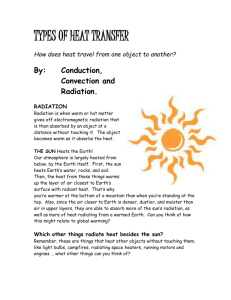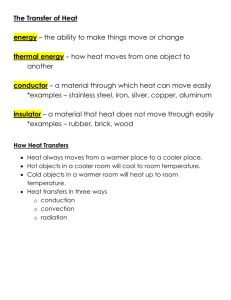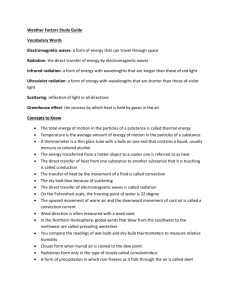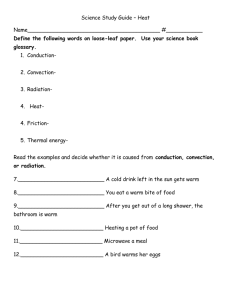6th Grade Benchmark #1 - PSUSDscienceresources
advertisement
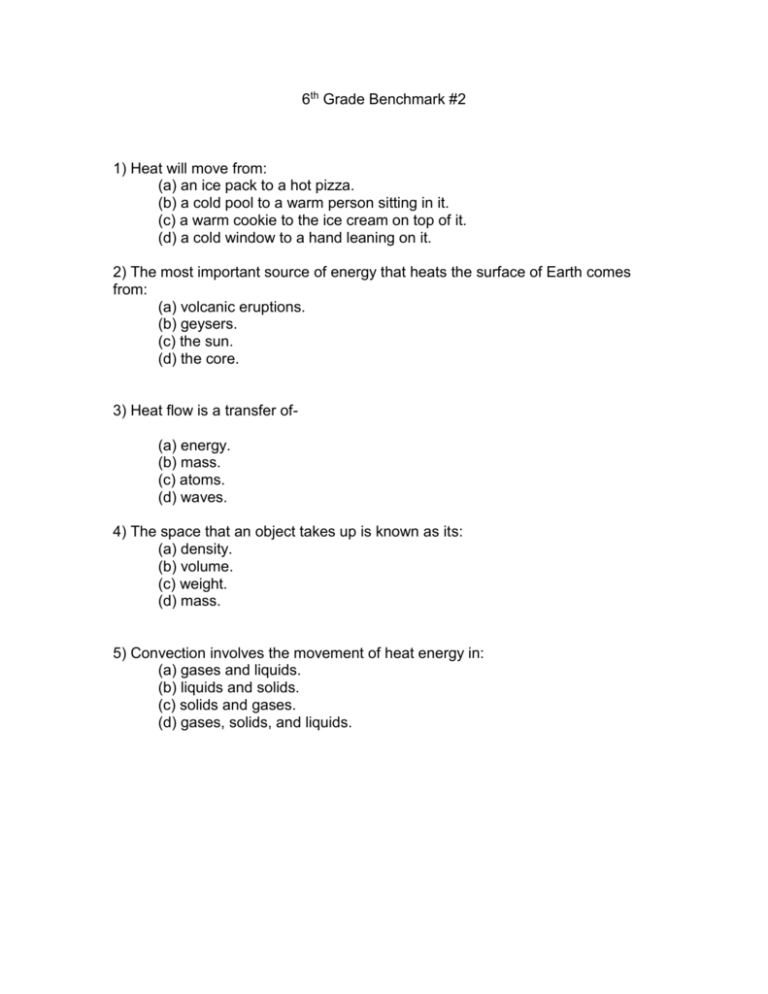
6th Grade Benchmark #2 1) Heat will move from: (a) an ice pack to a hot pizza. (b) a cold pool to a warm person sitting in it. (c) a warm cookie to the ice cream on top of it. (d) a cold window to a hand leaning on it. 2) The most important source of energy that heats the surface of Earth comes from: (a) volcanic eruptions. (b) geysers. (c) the sun. (d) the core. 3) Heat flow is a transfer of(a) energy. (b) mass. (c) atoms. (d) waves. 4) The space that an object takes up is known as its: (a) density. (b) volume. (c) weight. (d) mass. 5) Convection involves the movement of heat energy in: (a) gases and liquids. (b) liquids and solids. (c) solids and gases. (d) gases, solids, and liquids. 6) You mix 1 liter of water at 20°C with 1 liter of water at 60°C. What is the final temperature of the mixed water? (a) 20°C (b) 40°C (c) 60°C (d) 80°C 7) How does the density of a thin copper wire compare to a copper ring? (a) It is higher. (b) It is lower (c) It is the same. (d) You can’t tell without the numbers. 8) Warm air rises above cool air because: (a) warm air is less dense than cool air. (b) warm air is more dense than cool air. (c) warm air has the same density as cool air. (d) warm air has more weight than cool air. 9) The air near the ceiling of a classroom has a temperature of 30°C while the air near the floor has a temperature of 27°C. What conclusion can you make about the air in the room? (a) The air near the ceiling is more buoyant than the air near the floor. (b) The air near the ceiling is less buoyant than the air near the floor. (c) The air near the ceiling has the same density as the air near the floor. (d) The air near the ceiling is more dense than the air near the floor. 10) What is the main cause of seasons on Earth? (a) the distance between Earth and the sun. (b) the axial tilt of Earth. (c) the orbit of Earth. (d) the rotation of Earth. 11) If Earth absorbed (gained) more energy from the sun than was radiated (lost) to space, Earth’s average temperature would: (a) increase. (b) decrease. (c) stay the same. (d) become warmer in daytime and colder at nighttime. 12) You place a warm bottle of juice in ice water. After the bottle and the ice water have reached thermal equilibrium (a) the water and the juice have the same temperature. (b) the juice is cooler than the water. (c) the water is cooler than the juice. (d) the water is cooler than it was before. 13) Energy can be carried from one place to another by all of these EXCEPT− (a) sound. (b) light. (c) movement. (d) color. 14) A block that is 80ºC is placed next to a 20ºC block. The warmer block heats the cooler block by the process of− (a) convection. (b) conduction. (c) A and B. (d) neither A nor B. 15) The Sun warms the ocean and the land at a beach. The water and air above it heat up at a slower rate than the sand and air above the sand. This causes− (a) wind. (b) tides. (c) precipitation. (d) condensation. 16) Heat energy is transferred from the Sun to a cat sleeping on a sunny windowsill by− (a) convection. (b) conduction. (c) radiation. (d) combustion. 17) You take a soda can out of the refrigerator on a hot day. After a few minutes, you notice drops of water on the outside of the can. How did these drops of water get there? (a) The heat energy outside pulls water through small pores in the can. (b) The cold can causes water vapor in the air around the can to condense (c) The temperature difference causes a chemical reaction that forms water molecules. (d) The drops of water were already on the can when it was in the refrigerator 18) Wind occurs because air tends to move from regions of higher to lower (a) latitude (b) pressure (c) nitrogen levels (d) humidity 19) In the map above, the arrows that represent warm currents most likely move (a) Toward the equator. (b) Away from the equator. (c) Parallel to the equator. (d) West. 20) If you were giving a description of the weather today, which would you not need to include in the description? (a) The overall climate (b) Cloud cover (c) The high temperature (d) The percent humidity 21) Why would a person be cooler on a hot sunny day wearing a light colored tshirt and shorts than in a dark colored t-shirt and shorts made out of the same material? (a) dark colors are hotter (b) dark colors absorb more radiation from the sun (c) dark colors reflect more radiation from the sun (d) solar radiation avoids light colored objects Open Ended Question Cooking a hot dog requires transferring energy into the hot dog. Describe three different methods of cooking a hot dog that use different kinds of energy transfer. For each method, explain how the energy is transferred to the hot dog. ________________________________________________________________ ________________________________________________________________ ________________________________________________________________ ________________________________________________________________ ________________________________________________________________ ________________________________________________________________ ________________________________________________________________ ________________________________________________________________ ________________________________________________________________ ________________________________________________________________ ________________________________________________________________ ________________________________________________________________ ________________________________________________________________ ________________________________________________________________ ________________________________________________________________ Answer Key 1) C 2) C 3) A 4) B 5) A 6) B 7) C 8) A 9) A 10) B 11) A 12) A 13) D 14) B 15) A 16) C 17) B 18) B 19) B 20) A 21) B Open Ended Question Score 3- complete 2- partial 1- incomplete Criteria Student can identify 3 methods: one that uses conduction, one that uses convection, and one that uses radiation -and Student correctly uses the terms conduction, convection, and radiation -and It is explained how energy gets to the hot dog. For example: A hot dog in a frying pan cooks by being in direct contact with a hot pan. A hot dog in a microwave cooks by being hit by electromagnetic waves that carry energy. Student can only come with methods involving 2 types of heat transfer -or Students use of convection, conduction, and radiation is confused Student explanation of energy transfer is correct for at least two methods of cooking Student only can come up with ways of cooking a hot dog that use one type of heat transfer Students use of convection, conduction, and radiation is wrong Student doesn’t explain cooking in terms of energy
